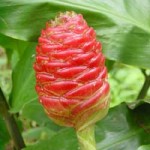I love Growing Gingers…
Say that in public and wait for the pursed lips, the little gasp of disapproval and the muted rumble of pearls being clutched all across the land.
DOC and MAF have done their job well. But wait. Not all gingers are weeds. Many of them are quite benign in our gardens and will never be a threat to our bush. Several of the Hedychium family of gingers produce fleshy fruits which are eaten by birds and dispersed through the bush.
That’s why these are the baddies in this country and they really are very bad.
But I am excited by the edible and medicinal gingers. Zingiber officinale is the common edible ginger. Its so easy to grow here as a tub plant in a warm spot or in a conservatory. The slender, metre tall shoots emerge in October, then the strange flower cones grow up from the soil in Autumn and the whole plant collapses for the winter.
The Zingibers are deciduous which allows them to handle our less than tropical winters. Freshly dug in Autumn and Winter it is juicy, succulent, sweet and aromatic, a far cry from the shrivelled, tired stuff that languishes on supermarket shelves.
Bitter ginger or Zingiber zerumbet, is another deciduous species.
The variegated form ‘darceyi’ is a strikingly lovely plant with metre high stems and broad cream and green leaves which emerge in October. The elongated green flower cones grow from the soil in late Summer, then turn a bright pink before the plant collapses in May. The cones contain a milky mucus which makes a great shampoo and it is known as the shampoo ginger in Hawaii. The root is ground to a pulp and used to treat bruising and sprains and drunk with water to ease indigestion, so it has many practical uses too.
Alpinia galangal is the wonderfully sweet, pine-scented ginger used in Thai food such as Tom Yum soup. Its a handsome bright green plant with broad, somewhat quilted leaves. (See catalogue web-page). It grows outdoors in a shady warm spot and we just dig a fresh piece of root up whenever we need it and the flavour takes me straight back to Thailand. The frozen fibrous supermarket alternative tastes very dead in comparison with the fresh young Autumn rhizomes. This one is not deciduous but gets tatty by late Winter, so I cut the old stems off when the new shoots start in October.
Grown in a pot the edible gingers are easy to tip out on the lawn to harvest a bit for dinner, then pop back in till next time. A clump of lemon grass, some coriander, shallots and chilli plants would complete your tropical spice garden.
So a sheltered courtyard garden can easily be a cornucopia of tropical spices that puts authentic pizzazz into your kitchen creations and looks sumptuously lush and colourful as well.
So its worth re-iterating that while MAF and DOC are doing a great job, just remember not all gingers are bad.
And as for those pearls; sweaty fingerprints and pursed lips are not a good look.



Hi Russell, Great information on the Gingers. I also have a white one Hedychium coronarium. Luckily it tolerates light frosts as we have been getting a few here in the Bay of Plenty. It has the most amazing perfume that floats around the garden and the flowers seem to last forever. I find whenever I have it in the Nursery (Earthforce), that it gets snapped up fast!!
Are any of these gingers suitable for growing in Southland? We live near the coast & get frosts up to 9 deg in winter.